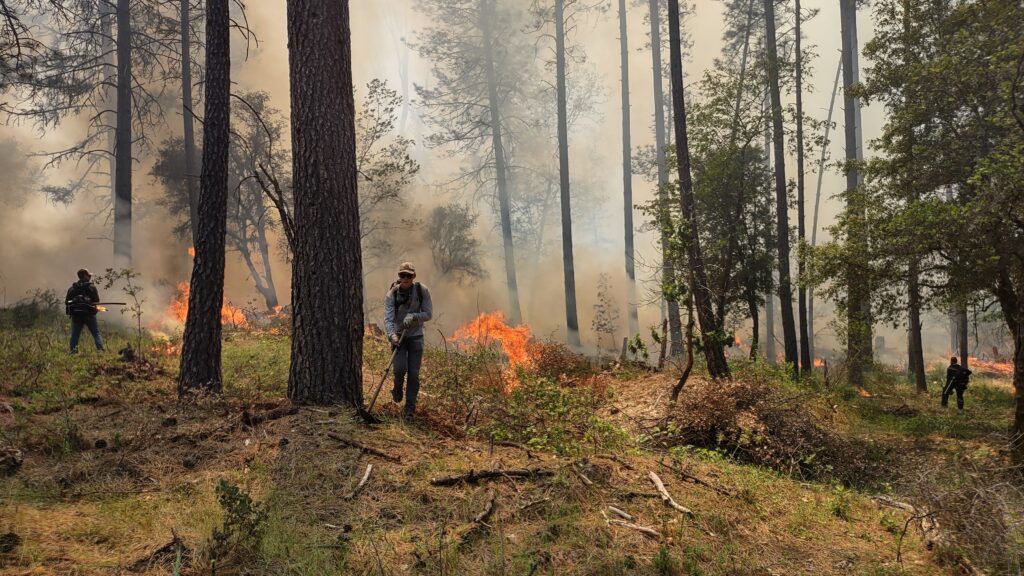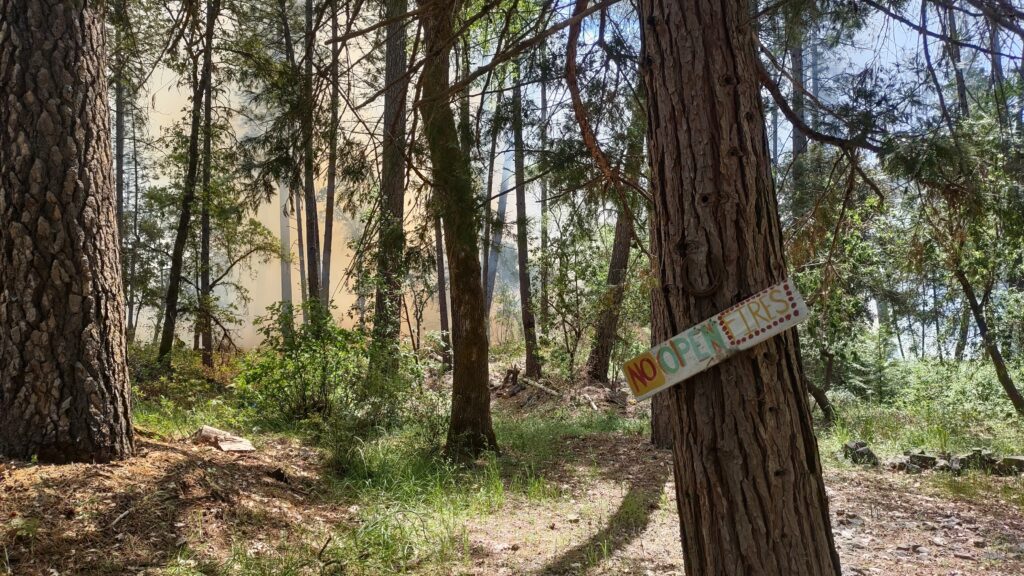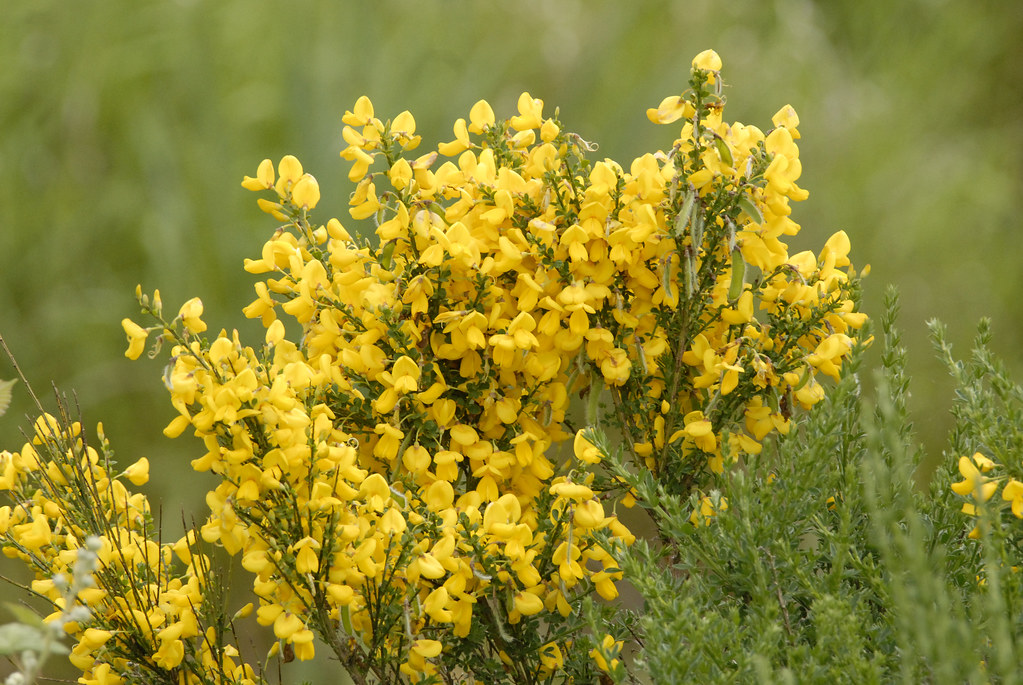
Crew members working on the Woolman School prescribed burn as part of the The Sierra Foothill Forest Climate Resilience Project (SFFCRP). Photo Credit: Matt Berry
On May 18th at the Woolman Outdoor School Campus, also known as the “Sierra Friends Center”, Sierra Streams Institute (SSI) coordinated a prescribed burn on 8.5 acres, which makes up approximately 3.5 percent of the total property. This controlled burn, conducted by First Rain Land Stewardship Services, was the first in over 100 years and the primary management objectives were fuel reduction, forest health improvement, and community participation and training. This prescribed burn fits within a larger 625 acre project: the Sierra Foothill Forest Climate Resilience Project (SFFCRP) that is headed by SSI and the County of Nevada Office of Emergency Services (OES) and funded by the Wildlife Conservation Board. This project aims to treat fire fuel on private and adjoining public lands at a “landscape scale” to reduce the likelihood of catastrophic fires occurring while ensuring understory habitat and climate resilience in the treated areas. The Nevada City School of the Arts and Shady Creek Outdoor schools are also within the footprint in addition to the Jones Bar FireWise Community and adjacent BLM land.
Thinning fire fuel is crucial because it leads to less intermingled trees and “ladder fuels” (fuels that fire can “climb” from the ground to the canopy), limiting the overlapping of vegetation. In turn, this reduces the risk of crown fires— fires that spread from tree to tree through the canopy. Crown fires are challenging to control and are known to move very rapidly when a dense canopy is available. For reference, the Jones Fire turned into a high severity crown fire in the southern portion of the Woolman parcel, resulting in 100% tree mortality and an eventual salvage log and tree replanting project.
Not only do prescribed burns disrupt fuel continuity to slow the rate of wildfire spread, they also reintroduce a natural process to a landscape that evolved with fire. Current estimates have indigenous and natural fires managing fuels across the west for over 12,000 years, and natural fires alone before that, sometimes burning a given location every 2-12 years in our region. Soil nutrient cycling, species succession and diversity, water infiltration and availability, and a suite of other natural processes in Sierra Nevada forests depend on fire. Reintroducing prescribed fire—including sometimes mixed-severity fires that mimic “natural fires” as well as lower severity fires that match historical indigenous practices—helps to not just serve as a band-aid one-time treatment of our overstocked forests; it also resets the system and restores a process by which nature can help manage itself.

This beneficial rule breaking stewardship event was open to the community with around 20 people attending including researchers from University of California Davis and staff of the Bear Yuba Land Trust. The burn went according to plan, with “excellent” consumption. Photo Credit: Matt Berry
What are the future fire management plans at SSI?
Over the next few weeks and months, SSI is going to monitor and assess the results of the Woolman School prescribed burn by using photo monitoring points that were established prior to the burn. This will allow SSI’s ecologists to record tree mortality and document vegetation regrowth rate including what specific species crop up after the burn which is an indicator for the effectiveness of potential future burns. Forest treatment on the property is expected to continue in one way or another as forest maintenance is a continued responsibility shared by the entire community. Next fall, SSI will kickstart the forest management process at another property, the Nevada City School of Arts (NCSA), by coordinating another prescribed burn with tribal partners. Fuel reduction and reintroduction of “good fire” will once again be a primary objective for that burn and in addition that burn will aim to reduce the monoculture of scotch broom, an invasive species that is found on the NCSA property. Over the summer, SSI’s forest ecologists are planning to collect scotch broom data at NCSA to conduct a before and after burn analysis and are hoping that the majority of the invasive plant ended up being engulfed by the flames during the fall burn. Further, the students at NCSA will be directly involved in monitoring of the property, expanding on their prior “Our Forests” curriculum conducted with SSI! Once enough of the scotch broom monoculture has disappeared from the property, a native plants revegetation project could start. Multiple burns might be required prior to reaching this stage since scotch broom has been found at the NCSA property for years and the soil seed bank is full of its dormant seeds.

While aesthetically pleasing (to some) and now commonly found in North America, the scotch broom is an invasive species. Photo Credit: Creative Commons
Why is it important to combat invasive species & what are they?
For a species to be labeled as “invasive”, it needs to meet the following two criteria. First, it must not be native to the area it is now found in. Second, it must be causing any type of harm, which can be interpreted as harming the local ecosystem and even simply harming the economy. Not all non-native species are invasive species. Scotch broom is native to Northern Africa and outcompetes native species in part due to its abundant seed production. This is harmful because our community loses valuable ecosystem services that native plants provide. Native plants benefit us as they provide more resources for biodiversity, are more water efficient, trap more carbon in the soil, maintain important relationships with symbiotic soil microbiota, and have deeper roots compared to most non-native species. These long roots play a key role in stabilizing the soil which reduces erosion that leads to natural disasters such as landslides and floods. Combating invasive species is generally done with management plans that focus on containing the spread of invasive species over the total eradication. This is due to the high costs linked with invasive species eradication. Each year, millions of dollars in California alone are spent on invasive species management projects to combat some of the 1,700 invasive species found throughout the state. The prescribed burn at the Woolman Campus and the future one at the NSCA campus are part of that larger vision to eliminate invasive species in favor of native ones that benefit our ecosystems and communities and are fire adapted.
What can I do to help?
The majority of wildlife fire activity in our area is human-caused.
- Learn about forest management and fire prevention to limit the impact of wildfires. Forest management is not one and done, maintenance is a shared and continued community responsibility. Follow burning compliance from CALFIRE: ditch spark powered tools, inspect your vehicles for sparks including dragging chains that cause sparks on the road way.
- Follow the recommendations of our Resource Toolkit for Landscape-Scale Management in Western Nevada County! In June, it is time to start clearing your roof and raking around your house.
- Mow Yellow Star Thistle and cut Scotch Broom if those invasive plants are found on your property, or reach out to SSI to get more suggestions on how to manage these plants in alternative ways; the jury is still out on the most effective method, and community experiments and sharing of information is always welcome!

